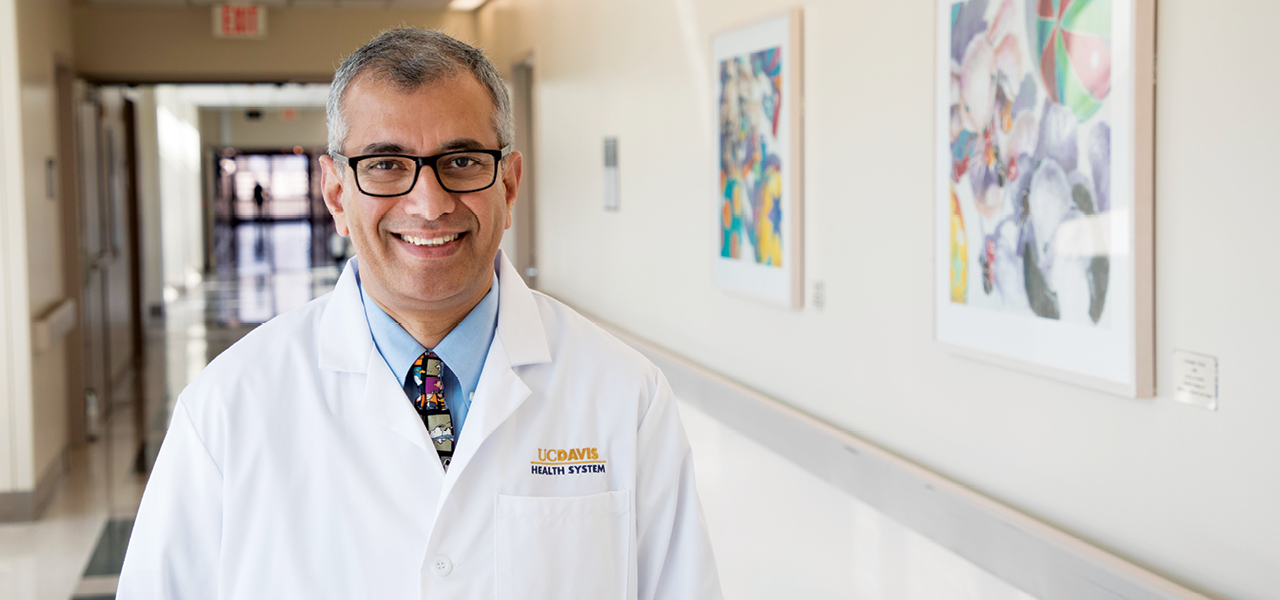
New pediatrics leadership
Meet neonatologist Satyan Lakshminrusimha, M.D., the new chair of the UC Davis Department of Pediatrics and medical director of UC Davis Children’s Hospital.
Neonatologist Satyan Lakshminrusimha joined UC Davis Health in December as chair of the Department of Pediatrics and medical director of UC Davis Children’s Hospital. He oversees 14 divisions and more than 300 faculty, staff and trainees through the department, which provides advanced care and research.
Before joining UC Davis, Lakshminrusimha was chief of neonatology and vice chair of pediatrics at the University of Buffalo and the Women and Children’s Hospital of Buffalo. As director of the university’s Center for Developmental Biology of the Lung, he supervised basic and translational research of lung development during the fetal and neonatal period, conducted by neonatology faculty and an interdisciplinary team of pathologists, physiologists and biophysicists.
Lakshminrusimha’s own neonatology research focuses primarily on the pathophysiology of the cardiopulmonary transition — how fetal lungs change at birth to breathe air — and related disorders such as birth asphyxia, persistent pulmonary hypertension of the newborn, retained lung liquid and respiratory distress syndrome. His translational research aims at prevention and treatment with optimal resuscitation techniques and use of steroids, nitric oxide, surfactant and oxygen.
Lakshminrusimha has been a prolific scholar and writer over the course of two decades, publishing almost 100 original peer-reviewed articles and several review articles and book chapters, and serving as a principal investigator or co-investigator on numerous grants. He currently serves as co-editor-in-chief of the open-access journal Maternal Health, Neonatology Perinatology and has served as an ad hoc reviewer for journals such as Pediatrics, the Journal of Perinatology, Pediatric Research, the World Journal of Pediatrics and the Journal of Pediatrics.
He is a fellow and committee member of the American Academy of Pediatrics (AAP), and was elected in 2006 to the Society for Pediatric Research and in 2008 to the Eastern Society for Pediatric Research. He is a member of the AAP’s neonatal resuscitation program steering committee and the neonatal-perinatal medicine sub board of the American Board of Pediatrics, and is an active member of the American Pediatric Society and Indian Academy of Pediatrics.
Q. What can you share about your vision and plans for the future?
UC Davis Children’s Hospital covers a wide geography encompassing 33 counties, including several physician-shortage areas. My primary aim is to enhance the care of children in our catchment area by providing subspecialty coverage through telemedicine or local clinics.
I’m keen on creating and promoting areas of excellence within the Children’s Hospital. As a department, we intend to recruit physicians and physician-scientists to add to our existing pool of talented providers to provide exceptional service to children in Northern California and beyond.
Q. What’s your take on the current landscape, both for referring community pediatricians and for pediatric academic medical centers? What are some of the biggest challenges, and how can we work together?
Fifteen to twenty years ago, community pediatricians frequently visited academic medical centers to care for their patients in newborn nursery or pediatric floors. With increasing limits on their time, they now remain in their clinics, and pediatric hospitalists care for these children at the medical center. This model has resulted in significant challenges in communication among providers.
Providing prompt feedback following an outpatient referral or hospital admission is crucial in maintaining a personal relationship between the Children’s Hospital and community pediatricians. Engaging community pediatricians with regular high-quality grand rounds (that can be accessed online) and educational opportunities brought to their doorstep is also important.
Q. What are some of your clinical care priorities in your new leadership role here?
Quality and patient safety, along with enhancing patient and parent satisfaction, are my primary clinical priorities in pediatrics. Other clinical priorities include increasing access to high-quality pediatric primary and subspecialty care irrespective of socioeconomic status. By promoting diversity among providers, we intend to make parents and patients feel at home during their visit to our clinics and hospital.
As mentioned previously, I am keen on establishing and promoting centers of excellence to provide quaternary and tertiary care to children with complex health issues.
Q. What are your research priorities?
I am a strong believer in clinical and translational research that brings novel ideas from bench to bedside and vice versa. The department has a strong foothold in areas of telemedicine, clinical trials and translational science. We have several young and enthusiastic faculty members keen on taking on a variety of research challenges, such as quality improvement and safety and health care delivery. Encouraging them and providing them with the right tools for success is my top priority.
Q. Priorities related to health education?
My aim is to provide research opportunities in pediatrics to medical, nursing and physician-assistant students, and to actively engage them in care.
Q. How would you describe your style of leadership?
The cornerstones are transparency, accessibility, mutual trust and appropriate delegation of tasks, along with having a personal 1:1 relationship with every member of my department.
Q. How did you decide on your field?
I was a medical officer in Indian Railways and experienced challenges faced by mothers in remote areas with poor access to health care. Birth asphyxia is a global problem resulting in almost a million deaths and lifelong neurodevelopmental impairment. I decided to enter the field of neonatology and pursue research in neonatal resuscitation.
Q. What’s new and on the horizon in neonatology, and how is this coming into play at UC Davis?
This is an exciting time in the field of neonatology. Several new developments to improve care of newborn infants are being investigated, such as:
- the use of stem cells to improve lung disease and spina bifida
- use of probiotics to improve pulmonary and intestinal/nutritional outcomes
- delayed clamping of the umbilical cord at birth to promote transfusion of blood from the placenta to the baby, and
- use of new medications to improve outcomes in congenital diaphragmatic hernia.
UC Davis Health physicians and surgeons are actively participating in these research endeavors.
Q. Will you continue to provide patient care, conduct research, or teach in your new role?
Yes, absolutely. I enjoy every aspect of my job — patient care in the NICU, clinical and translational research, teaching residents and fellows, and administration.
Q. What’s been your greatest experience as a physician or physician-scientist?
I have cared for several newborn infants with major health issues, and seeing them grow into active children and young, talented adults has been rewarding as a physician.
As a physician-scientist, I am pleased that a bench-to-bedside project involving the use of milrinone in congenital diaphragmatic hernia is currently recruiting patients through a multicenter trial sponsored by the NICHD.
The achievement that I relish most is seeing my residents and fellows achieve great heights. As a parent, nothing gives you more happiness than to see your children succeed. Similarly, as a mentor, I have been blessed to have played a small role in the academic success of over a dozen residents and fellows. I was humbled when the Eastern Society of Pediatric Research presented me with the “Mentor of the Year” award in 2016.
Q. Is there anything else you’d like our referring physicians and patients to know?
Every time I care for a critically ill neonate in the NICU, I ask myself, “If I were the parent of this child, how would I like the physician to communicate with me and treat my child?”
Q. You’ve published more than 100 medical illustrations in textbooks, journal articles and apps. Can you tell us more about your interest in this area?
I have always enjoyed drawing simple line diagrams to explain complex pathophysiology to trainees and parents. I am currently editing a book on neonatal ventilation and am drawing over 100 illustrations for this book. The app “Illustrative Neonatology” developed by my former colleagues in Buffalo is a free download for educators and parents all over the world.
Q. Can you tell us a bit about your personal interests and hobbies? What’s life like for you outside of the office?
I enjoy reading comics and watching DC/Marvel comic-based movies with my three children. I enjoy drawing illustrations for presentations and textbooks. I like biking on weekends along the American River. My wife and I are huge fans of Stephen Colbert and regularly watch The Late Show every night.
Q. What’s the best advice you’ve ever been given?
Enjoy your work and consider your colleagues as your family.
Q. What are you reading now, and what’s your favorite book?
My favorite book is Emperor of all Maladies by Siddhartha Mukherjee. I am currently enjoying the DogMan series with my 9-year old son.


